�
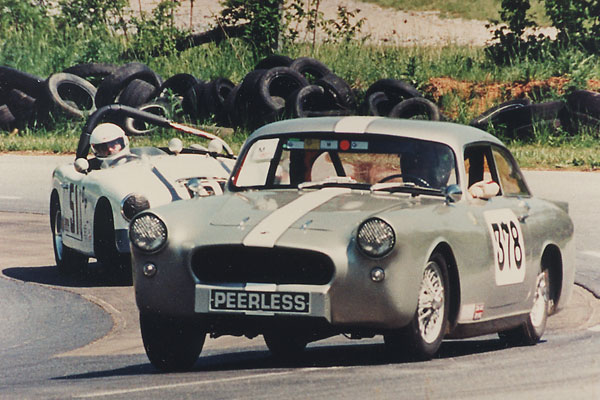
�
Mark Rosenberg's 1959 Peerless GT leads a Turner sports car in the Jefferson 500 at Summit Point.
�
Mark Rosenberg's 1959 Peerless GT Race Car
� Owner: Mark Rosenberg� � City: Baltimore MD
� Model: 1959 Peerless GT
� Engine: Triumph TR3/TR4 (see below)
� Originally race prepared by: Treasured Motorcars, Owings Mill MD (1990)
� Race prepared by: Merryman Modifications, Hanover PA (currently)�
�
History of Peerless Cars
��
Hotelier and restaurateur James ("Jimmy") Byrnes recruited Bernie Rodgers to design �
a racing car. Although the original goal was a one-off car for club racing, the two �
men ended up with a small car company. Things like that sometimes happen if you�
know the right people, and Jimmy Byrnes met lots of people though his restaurant.�
�
The old "Saxon Mill" restaurant in Warwick was a favorite of the Board of Directors�
of the Standard Triumph car company. Having become friends with the Board, Byrnes was �
naturally interested in utilizing Triumph parts in the proposed racecar. He �
instructed Rodgers to use Triumph TR3 components wherever they would suit. �
�
| � From very early on, Bernie Rodgers imagined that a multi-tube frame constructed � mainly of 16-gauge 1" x 1.5" rectangular steel tubing might be a very practical � basis for a small sports saloon. Byrnes commissioned an all-aluminum body, a � Triumph TR3 drivetrain was procured, and a prototype car was constructed. As the � pieces came together, the prototype was initially given the name "Warwick". � As Byrnes and Rodgers drove the Warwick and showed it to their friends, they � realized other people were interested in owning one too. They decided to test � the waters and determine if it might make sense to build a whole batch of cars.� | �� | �
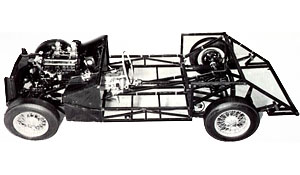 � (Peerless promotional illustration)� | �
�
Byrnes showed the prototype car to an old army friend named John Gordon, who had a �
used car dealership. Gordon agreed that the prototype's performance was impressive, �
but he suggested enlarging and widening the body. This suggestion was based on his �
perspective as a car salesman, but it provided a performance benefit too, especially �
because with wider track Bernie Rodgers decided it was feasible to fit a de Dion �
suspension instead of a Triumph TR3 live axle. John Gordon joined the project team, �
and the three partners made plans for a more public testing of the market.�
�
A second aluminum bodied Warwick prototype was built and shown at the 1957 Paris �
Motor Show. You could hardly call them a company yet, but based on public reaction at �
that show the three men were already thinking of a production rate of 1500 cars per �
year. One American car dealer told them he was confident he could personally sign �
for eighty cars per month. Much more importantly, the second prototype was extremely �
well received by Jimmy Byrnes' friends on the Standard Triumph Board of Directors. �
They evidently believed that the Warwick could only embellish the prestige of their �
own products. Triumph would provide necessary components, and indeed would provide �
components at a favorably low cost. �
�
�
Enjoying this article? www.BritishRaceCar.com is partially funded through generous support from readers like you!
�
To contribute to our operating budget, please click here and follow the instructions.
�
(Suggested contribution is twenty bucks per year. Feel free to give more!)�
�
The model name change from Warwick to Peerless occurred after the entrepreneurs settled �
into a physical address. They had acquired a bankrupt car dealership upon whose �
property American-made Peerless military trucks had previously been stored and serviced, �
and they decided the name Peerless suited their own ambitions nicely. It almost goes �
without saying that they hoped to export a lot of cars to America, and they imagined �
the bold new name would help. (The Peerless company of Cleveland Ohio no longer built�
automobiles.)�
�
Due to a lack of funds for press tooling, the newly formed Peerless Cars Limited decided �
to use fiberglass for production bodies. This was a gamble because at the time there �
were no well-known fiberglass cars in the British marketplace. Indeed, the only �
"mass produced" fiberglass passenger car in the world was the Chevrolet Corvette. �
(The Daimler SP250 was being developed �
and introduced at almost the exact same time as the Peerless GT. A few other small-scale �
and specialty manufacturers like Turner �
seemed to be having good success with fiberglass.) If customers were risk averse, �
fiberglass might be a turn-off. Would it be durable? How would it weather and age? �
The new material would present new technical and manufacturing challenges too, but �
this was a brand new company that would be learning its way in any case.�
�
�
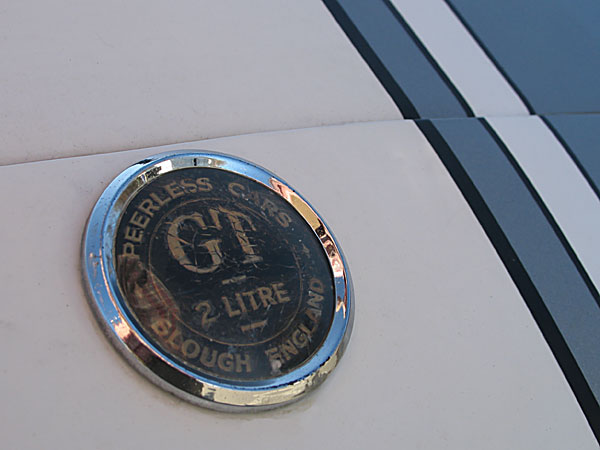
�
Peerless Cars, GT, 2 Litre, Slough England.
�
�
Peerless hired a local coachbuilding company named James Whitson Ltd. to produce�
their fiberglass bodies. Initial cost was acceptable; and fit and finish seemed �
adequate. �
�
To prove their new car, the company entered a Peerless GT in the 1958 24 Hours of �
LeMans race. Peter Joppe and Percy Crabb drove the British Racing Green number �
"24" car to 16th place overall and 4th place in the two liter Sports class. The team �
only made scheduled pit stops, and they lost just seven minutes to downtime. They �
kept up a brisk pace too, averaging 83.6mph despite many hours of rain and at least �
one period of torrential downpour, to complete 240 laps and a total distance of over �
2006 miles. Incidentally the Peerless was the only Triumph-powered car entered;�
racing success for Peerless was seen as very good publicity for Triumph.�
�
At this stage in the company's life, sales weren't a problem. They couldn't build cars �
fast enough. Their main difficulty was that fiberglass construction is labor intensive. �
It's hard to rush production without investing in more moulds and more operators. �
After about 250 cars had been produced, Peerless decided to revise the body design to �
incorporate many improvements, and simultaneously to transfer their supply agreement �
from James Whitson Ltd. to a company named Wincanton Transport and Engineering Company. �
The Phase One and Phase Two bodies look quite similar, but in fact the manufacturing �
processes that created them were very different. During Phase One construction, 57 �
different molded parts were bonded together to create a bodyshell that was then bonded �
and pop-riveted to the tubular steel chassis. In contrast to that, each Phase Two �
bodyshell was constructed as a single elaborate part created in a large, very �
elaborate, multi-section mould. The mould held panels aligned as the structure became �
increasingly complete, stiff, and strong. Phase two bodyshells were bolted (removeably)�
to the tubular steel chassis. �
�
Regrettably, there isn't a whole lot more to tell about Peerless Cars Ltd. The company �
principals had a falling out. John Gordon left, and with him Peerless lost its �
principle salesman and promoter. He would later join forces with Jim Keeble to form �
Gordon-Keeble Cars Ltd. About a hundred small block Chevy powered Gordon-Keeble cars �
were produced between 1963 and 1966. Bernie Rodgers and Jimmy Byrnes salvaged the remains �
of Peerless Cars Ltd. by forming a new company and continuing production on a smaller �
scale. They reverted to the original model name: Warwick. About forty Warwick GT's �
were built, some with marvelous Buick 215 aluminum V8 engine (which was notably lighter�
weight and fifty-five percent more powerful), before the company folded in 1962. �
�
�
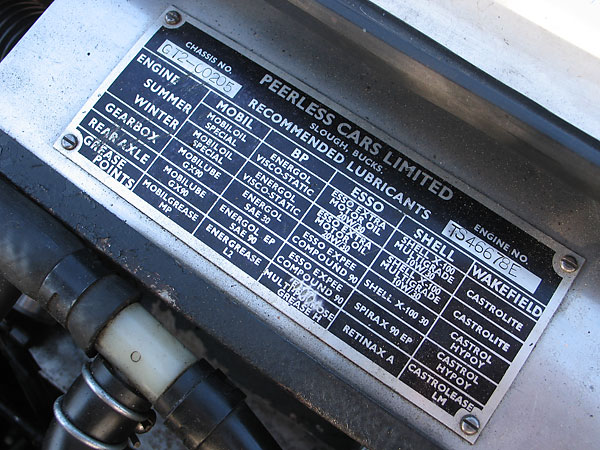
�
Peerless Cars Limited, Slough, Buckinghamshire
�
Chassis No. GT2-00205, Engine No. TS46678E
�
Mark Rosenberg's Peerless GT (Phase One)
��
Mark's Peerless GT is number 205 of 325 produced. It's one of approximately seventy�
left-hand-drive Peerless cars which were exported to the United States. �
�
The car was originally set-up for racing by John ("Jake") Jacobson of Old Spokes �
Vintage Racing of Newark Delaware in 1990. Since April 1991, Mark has driven it in �
35 events including seven Pittsburg Vintage Grand Prix appearances and seven Jefferson �
500 appearances. �
�
Mark's Peerless is maintained, race prepared, and gradually refined by Jack Merryman of �
Merryman Modifications in Hanover Pennsylvania, and by Geoffrey Griffiths of �
Treasured Motorcars of Owings Mills, Maryland. �
�
Peerless GT's were originally built with stock Triumph TR3 engines, which had 83mm bore �
wet cylinder liners, and a total displacement of 1991cc. Mark's engine has been re-sleeved �
to 86mm for a displacement of about 2138cc, which is nominally the same as a Triumph TR4. �
Many other modifications have been made for racing, as described in more detail below. �
On the chassis dyno for tuning, the engine pulls about 130bhp.�
�
 �
�
�
�
Features and Specifications
�| Engine: | �rebuilt with larger cylinder sleeves (86mm in lieu of 83mm.)�
Billet connecting rods. Aluminum racing pistons. �
Ported big-valve cylinder head, milled to unshroud the valves and �
increase compression ratio. (Static compression ratio is ~10:1.)�
Double valve springs. Titanium collars and keepers.�
Chrome moly pushrods. Lightened and hardened tappets.�
Camcraft nitrided race camshaft.�
Dual S.U. 1.75" carburetors.�
Mallory dual point distributor.�
Lucas Sport ignition coil. �
Packard 440 (7mm copper core) spark plug wires.�
Competition oil pump with Ford V8 pick-up. �
Purolator adapter for spin-on oil filter, connects to a spin-on oil cooler adapter.�
Oil cooler. Remotely mounted (Pennzoil PZ-34) oil filter. �
| �
| Cooling: | �custom 5-row copper/brass radiator.�
Electric cooling fan. | �
| Exhaust: | �Triumph TR3 tri-Y (4-2-1) header, modified to fit, feeding to open exhaust. | �
| Transmission: | �Triumph TR4 4-speed (without overdrive).�
Centerforce clutch. � Lightened TR4 flywheel.� Driveshaft rebuilt with Volvo yokes, etc. | �
| Rear End: | �Salisbury open differential with 3.7:1 gear ratio. | �
| Front Susp.: | �Triumph TR3 derived dual wishbone front suspension with Cam Gears worm �
and peg steering box, upgraded with SPAX shock absorbers and oversized �
front anti-sway bar mounted on aluminum pillow blocks. | �
| Rear Susp.: | �stock de Dion tube located on custom semi-elliptic leaf springs. �
Armstrong lever shock absorbers, upgraded with race valving. | �
| Brakes: | �(master) single Girling remote-reservoir master cylinder. � (front) 10.75" Brembo rotors. Carbotech carbon fiber brake pads. � (rear) 10" drums. | �
| Wheels/Tires: | �Dunlop 15x4.5" 60-spoke wire wheels. Dunlop Racing tires (5.50L15). | �
| Electrical: | �Lucas generator.�
12V lead acid battery.�
Lucas windshield wiper system. �
Dual electric horns. | �
| Instruments: | �Jaeger speedometer and mechanically driven tachometer.�
Smiths ammeter and fuel level gauge (not used). � Stewart Warner coolant temperature and oil pressure gauges. | �
| Fuel System: | �Fuel Safe 12 gallon fuel cell.�
Facet solid state fuel pump. | �
| Safety Eqmt: | �5-point roll structure.�
Kirkey aluminum racing seat (16", 41500V). � Simpson latch-and-link harness.� Wink wide view mirror. | �
| Weight: | �~2400 pounds. | �
| Racing Class: | �over two litre, production. | �
Engine Installation
��
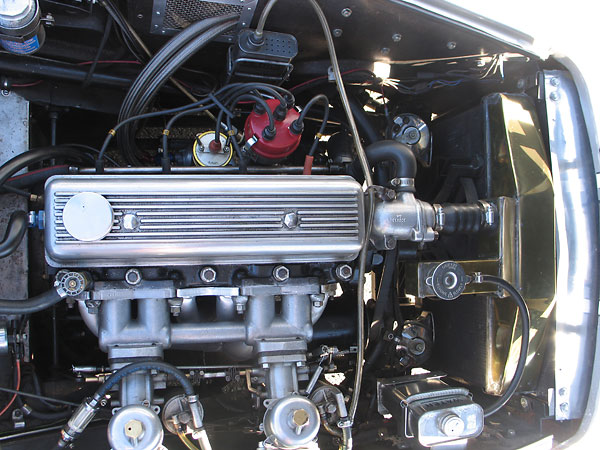
�
Triumph TR3 engine, rebuilt with larger cylinder sleeves (86mm in lieu of 83mm).
�
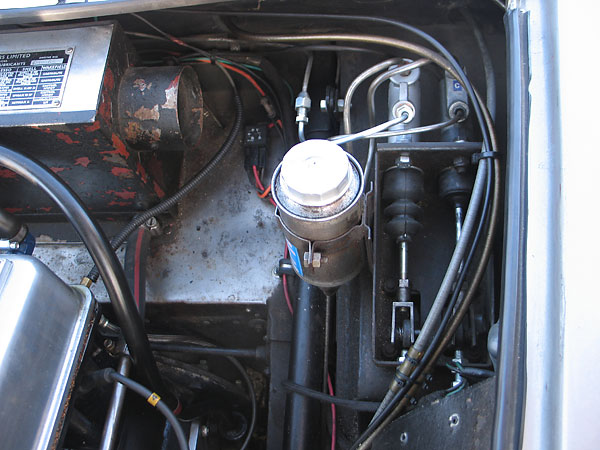
�
Single Girling remote-reservoir brake master cylinder.
�
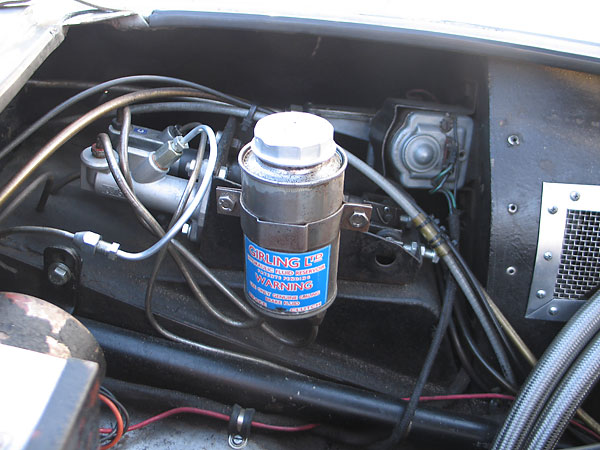
�
The Lucas windshield wiper system remains in place. Good windshield wipers were critical to the
�
success of Peerless in the 1958 24 hours of LeMans race.
�
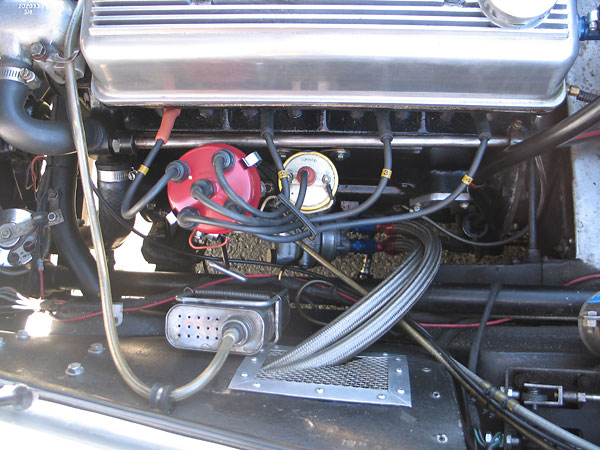
�
Oil cooler plumbing.
�
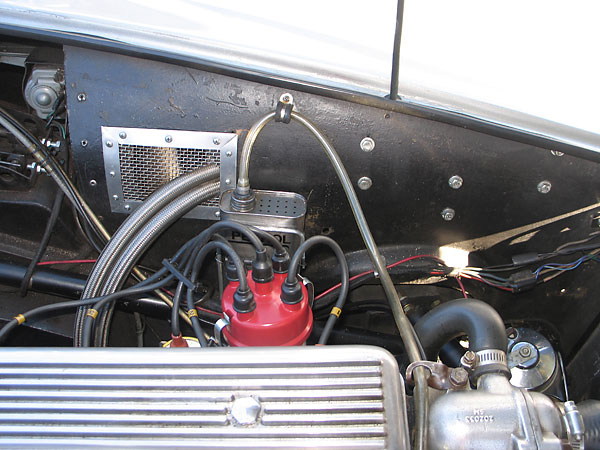
�
Mallory dual point distributor. Lucas Sport ignition coil.
�
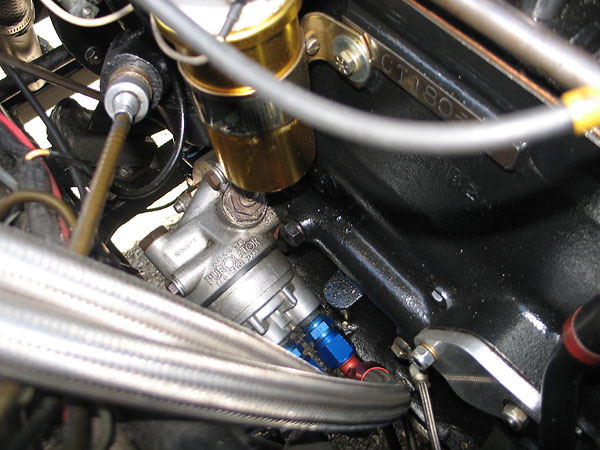
�
The cable for the mechanical tachometer connects at the base of the distributor, driven off the camshaft.
�
It's never given any problems. The Triumph engine also has provisions for a camshaft driven fuel pump,
�
although the Peerless came with dual S.U. electric pumps instead. Notice the stainless steel braided
�
hose that's connected to an oil galley a couple inches below the fuel pump blockoff plate. It was added
�
to provide supplemental lubrication to the valvetrain.
�
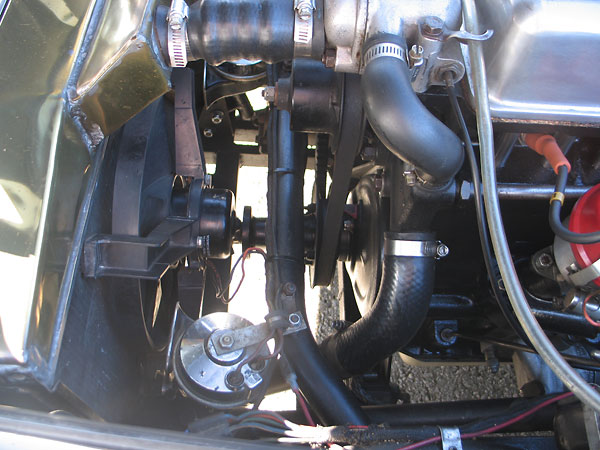
�
Electric cooling fan and dual electric horns.
�
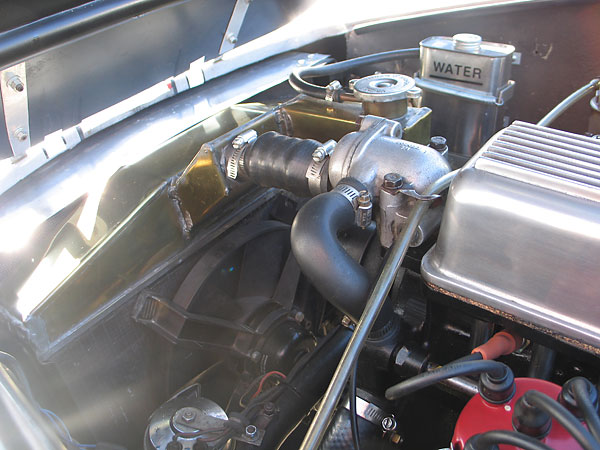
�
Thermostat housing.
�
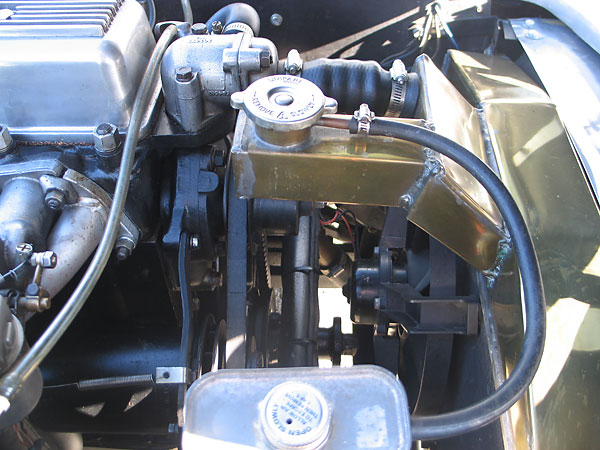
�
Left: Lucas generator. Right: generously sized custom 5-row radiator and electric cooling fan.
�
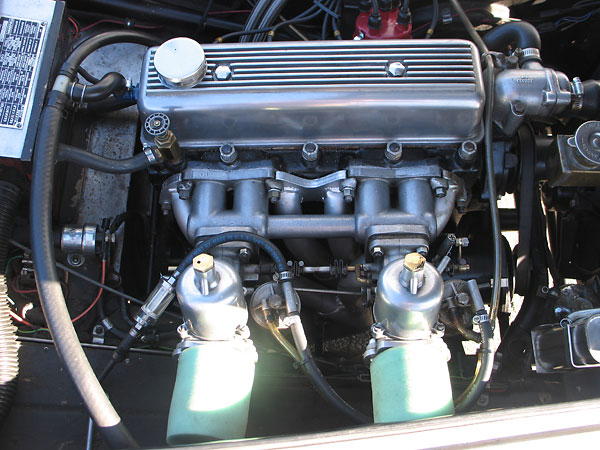
�
Triumph intake manifold and exhaust header flanges.
�
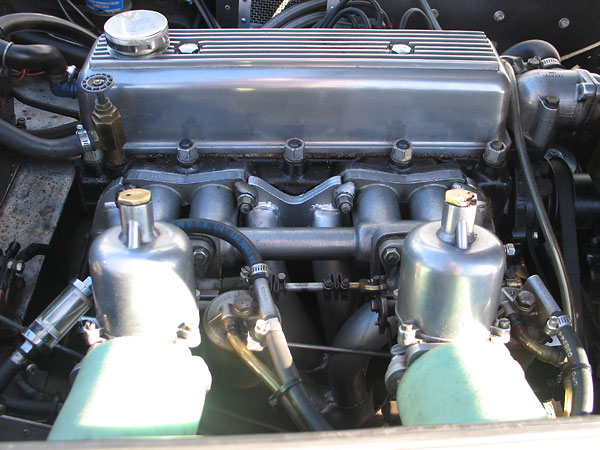
�
Dual S.U. 1.75" carburetors.
�
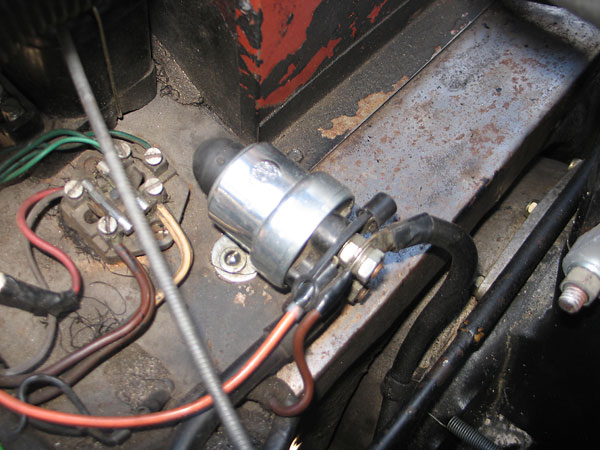
�
Remote starter switch.
�
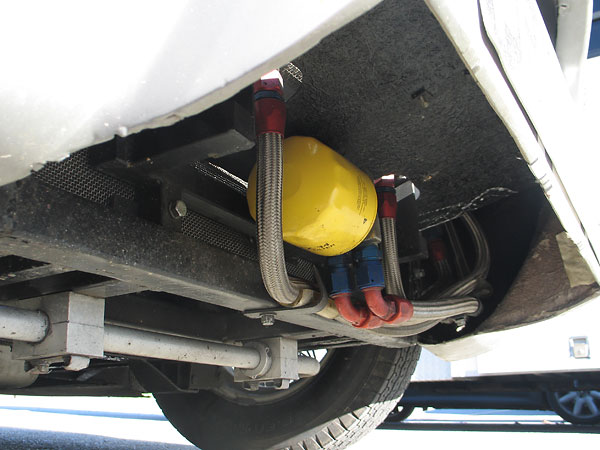
�
Remotely mounted (Pennzoil PZ-34) oil filter, and oil cooler connections.
�
�
Front Suspension
��
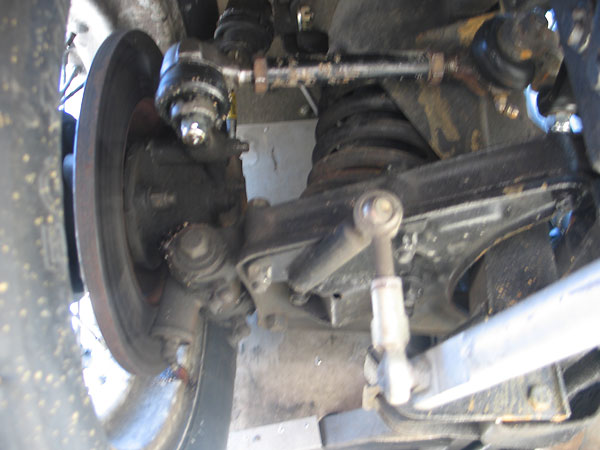
�
Triumph TR3 dual wishbone front suspension, upgraded with SPAX shock absorbers.
�
(The shock absorbers can't easily be seen because they're inside the coil springs.)
�
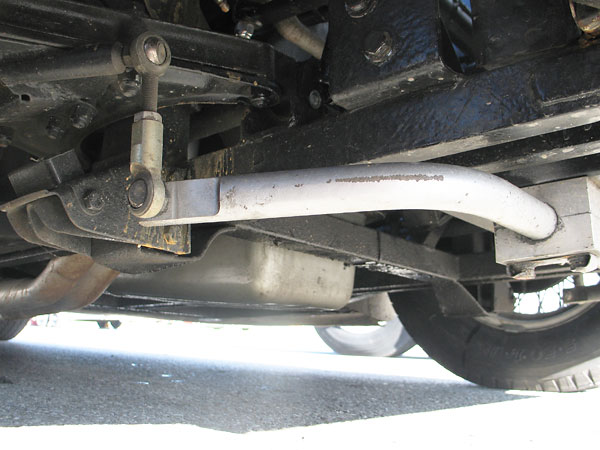
�
Oversized front anti-sway bar mounted on aluminum pillow blocks.
�
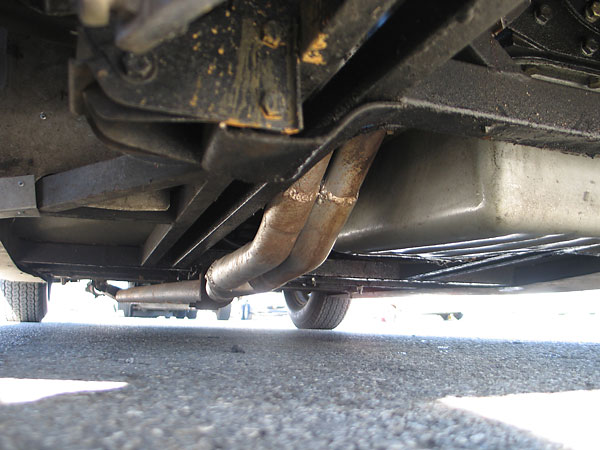
�
Details of the Peerless chassis, and also the long secondaries of the tri-Y header.
�
(The Triumph TR3 header had to be modified to fit the Peerless.)
�
Rear Suspension
��
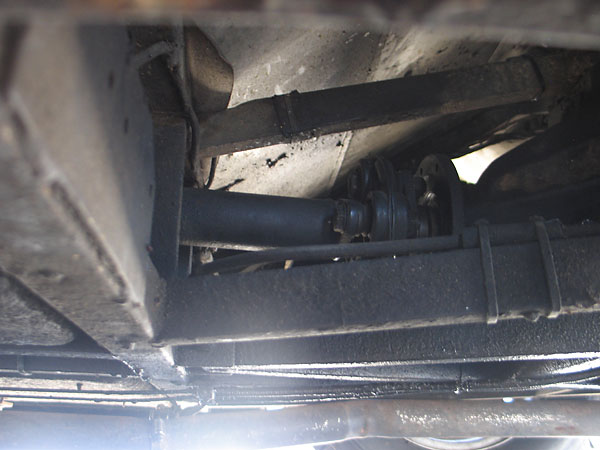
�
The Salisbury differential is mounted rigidly to the Peerless GT chassis.
�
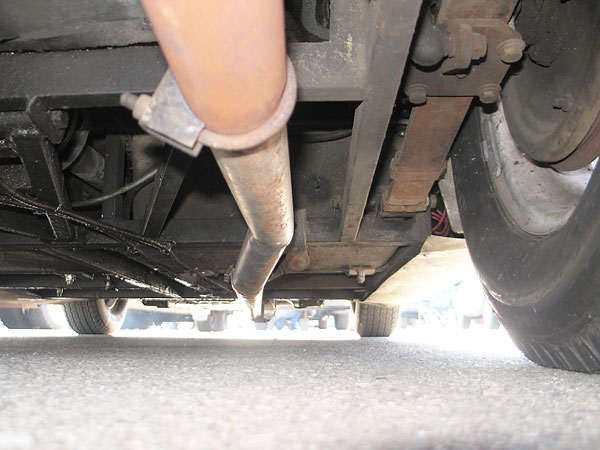
�
Mark discovered that replacement Triumph TR3 leafsprings won't fit on the Peerless GT. Instead, he
�
needed to have custom springs made. After a lot of trial and error he found that this softer, flatter
�
two-leaf spring worked best. His lever-arm rear shock absorbers have also been custom tuned.
�
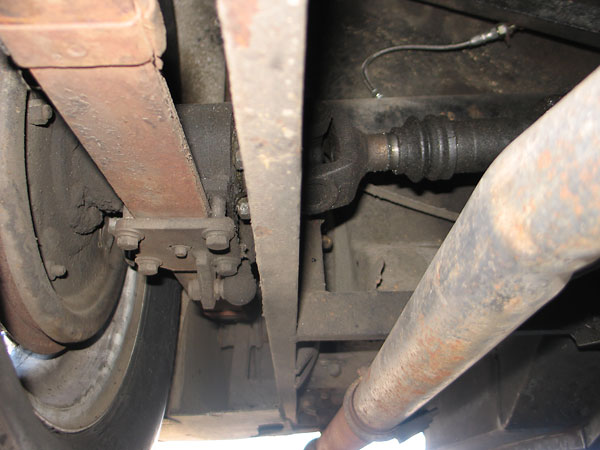
�
The de Dion tube which connects the rear hubs is just visible behind the telescoping halfshafts.
�
�
Interior
��
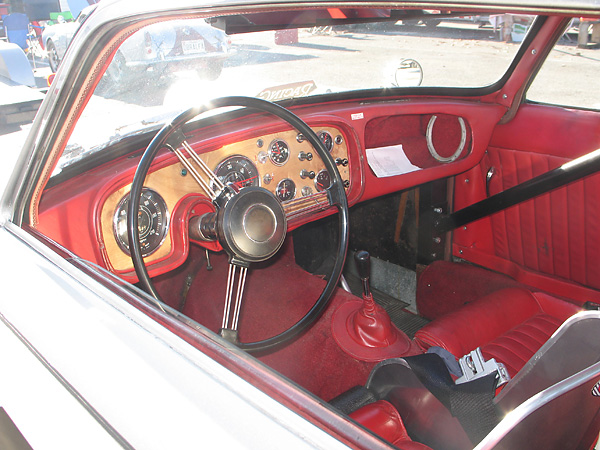
�
In the 1950's and early 60's it was sometimes considered unsporting to strip interior trim from a racecar.
�
Mark Rosenberg's Peerless GT includes a horseshoe for good luck, screwed down within driver's sight.
�
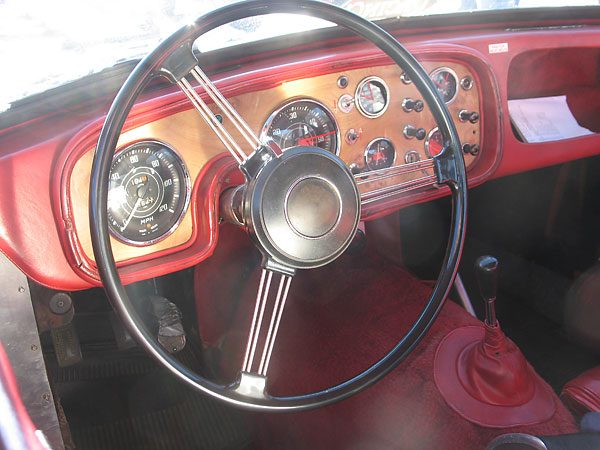
�
Jaeger speedometer and mechanically driven tachometer. Smiths ammeter and fuel level gauge (not used).
�
Stewart Warner coolant temperature and oil pressure gauges.
�
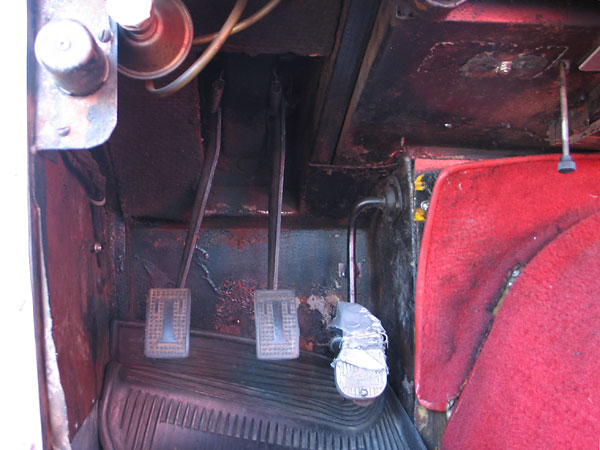
�
The Paddy Hopkirk style throttle pedal is connected to the carburetors through a mechanical linkage.
�
(Incidentally, the choke is also worked by a linkage instead of a cable.) The original foot-operated
�
headlight dimmer switch has been relocated away from the pedals and can be seen here in the upper,
�
lefthand corner of the photo. Next to it, a vacuum switch controls the windshield washer system!
�
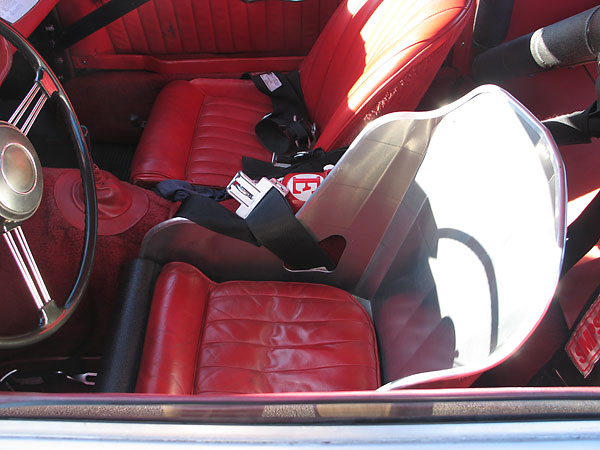
�
Kirkey aluminum racing seat (16", 41500V). The back seat has been removed to reduce weight. Now,
�
quickly removeable panels facilitate convenient access to the differential and rear suspension.
�
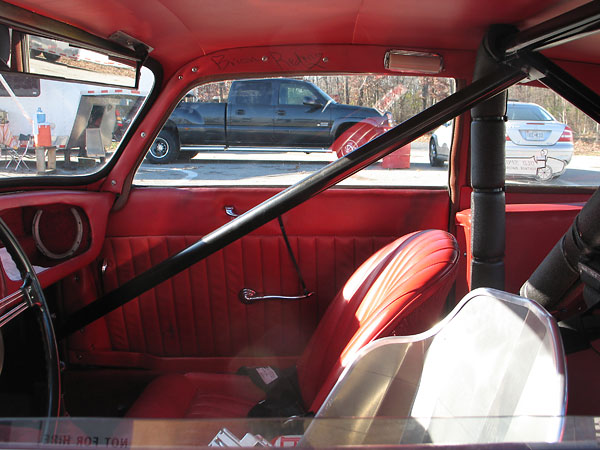
�
Peerless adapted a Rolls Royce window regulator mechanism. Instead of having a crank (with gears), the
�
window lift is simply a lever that moves between twelve o'clock and three o'clock positions. It works great!
�
The window rises quickly and smoothly. Notice driver Brian Redman's autograph above the door window.
�
Dickie Attwood's autograph is written above the driver's side door window.
�
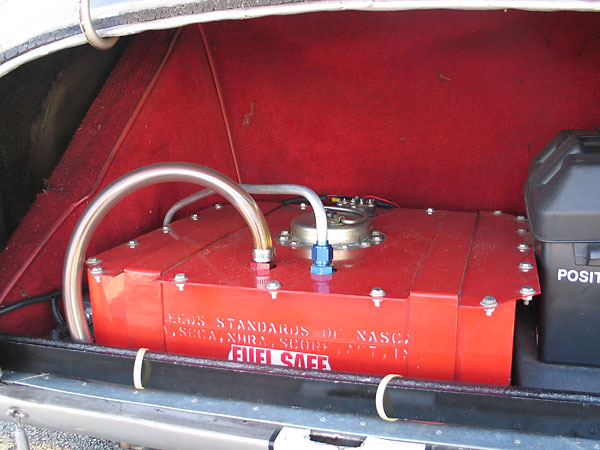
�
Fuel Safe 12 gallon fuel cell.
�
�
Exterior
��
�
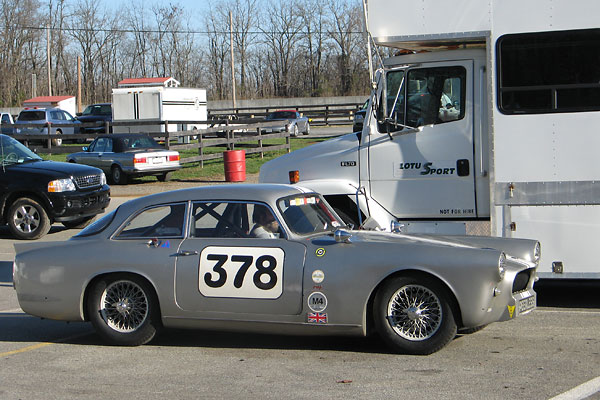
�
After creating two aluminum prototypes, all production Peerless GT's had fiberglass bodies.
�
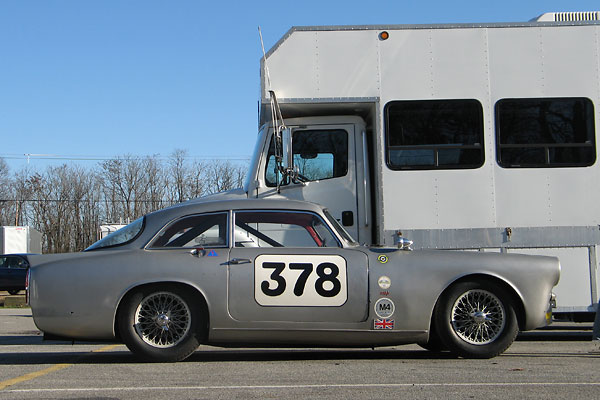
�
The biggest difference between the ~250 Phase One bodies and the ~75 Phase Two bodies was how they
�
were made. However, the later fabrication techniques did result in a shell that was lighter and stiffer.
�
Underneath, the steel frame wasn't changed between Phase One and Two. It weighed just 123#.
�
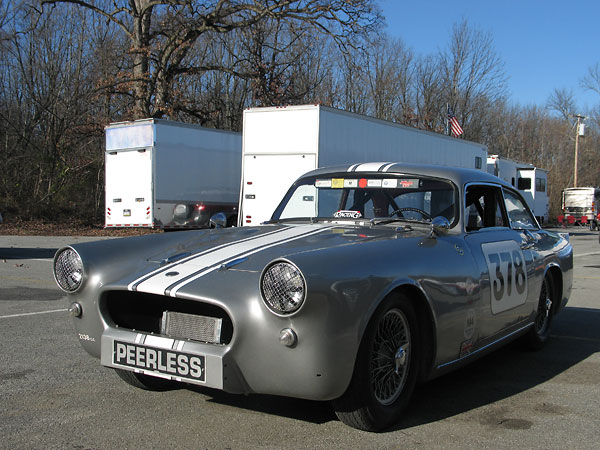
�
For racing, the original sylized-"P" radiator trim has been removed from Mark's Peerless GT.
�
(Phase Two cars would be fitted with recessed grille.)
�
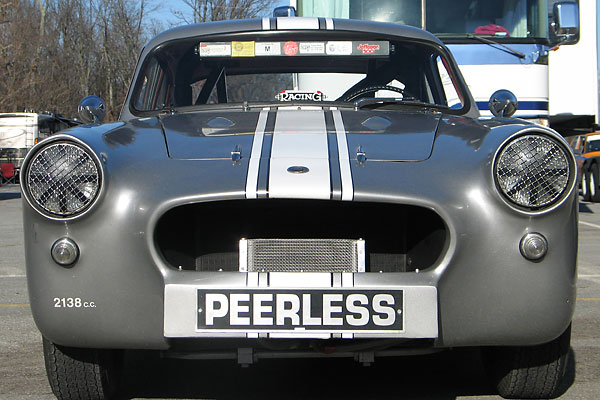
�
The narrow A-pillars that frame the sides of the windshield are great in terms of visibility, but
�
they're one of the most fragile and crack prone parts of the fiberglass Peerless GT bodyshell.
�
Incidentally, the Peerless GT windshield is identical to a Morris Minor rear window.
�
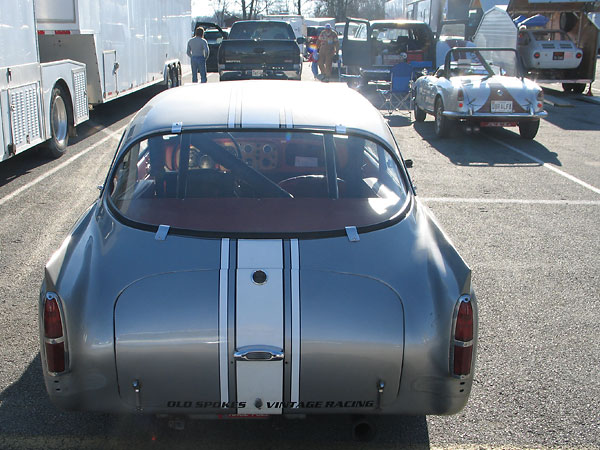
�
Aside from the body, frame, soft interior trim, and de Dion tube, very few parts of the Peerless GT were
�
designed specifically for or by Peerless. The taillights Peerless used, for example, were also used on
�
the Bentley Continental S1, Humber Super Snipe (some years), Aston Martin DB4 and Alvis TD 21. The
�
license plate lamp was used by Rover and Jaguar. The rear window, however, seems to be unique.
�
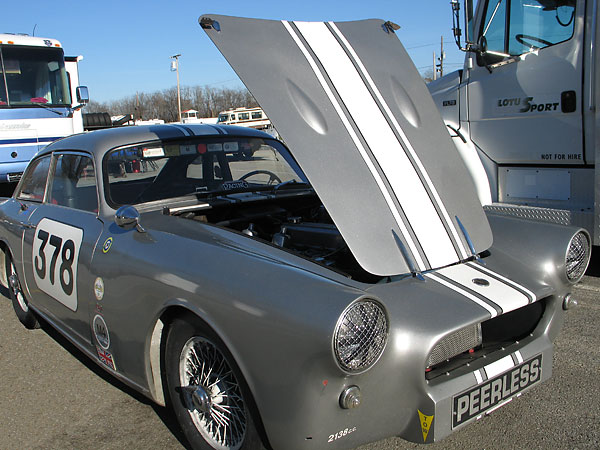
�
With Phase Two the door, bonnet, and boot hinges were all modified to include automatic stops...
�
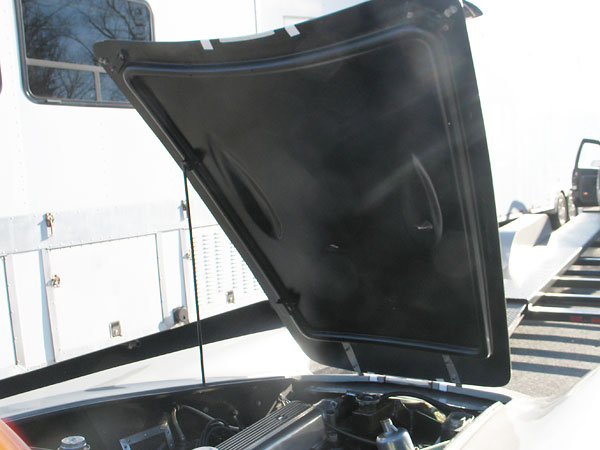
�
... and a single offset blister would replace the original bonnet "double-hump".
�
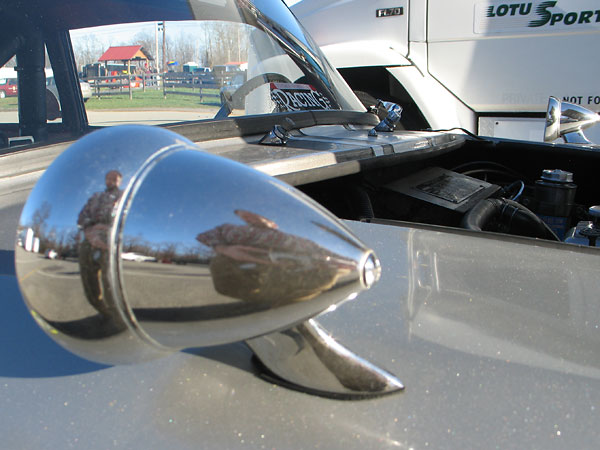
�
Mirrors.
�
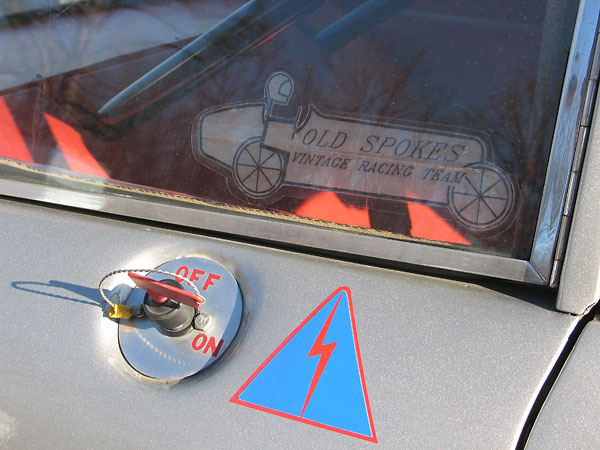
�
The passenger side fuel filler has been removed and replaced with an emergency engine "kill" switch.
�
Old Spokes Vintage Racing Team window decal.
�
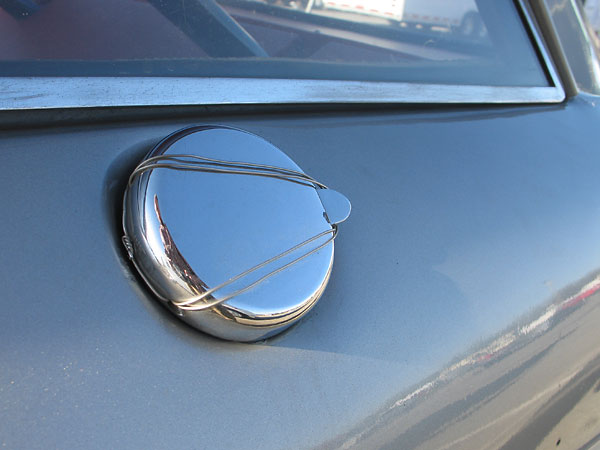
�
The driver side fuel filler has beem safety wired shut, although it's not connected to a fuel tank.
�
The Peerless GT originally came with dual fuel tanks, with a total capacity of 14 Imperial gallons,
�
and dual S.U. electric fuel pumps. The whole system was removed, for a significant weight reduction.
�
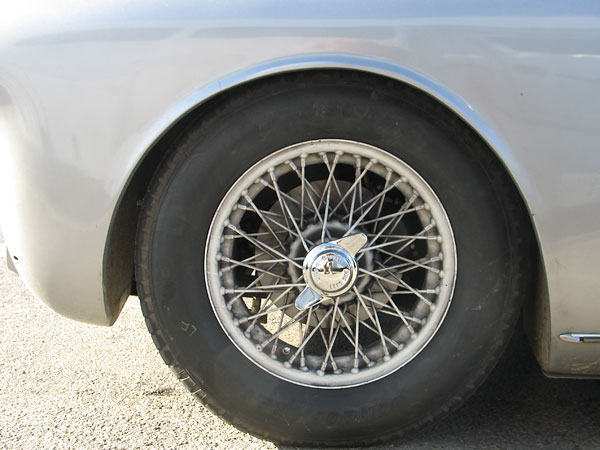
�
Dunlop 15x4.5 60-spoke wire wheels with Dunlop Racing tires (5.50L15).
�
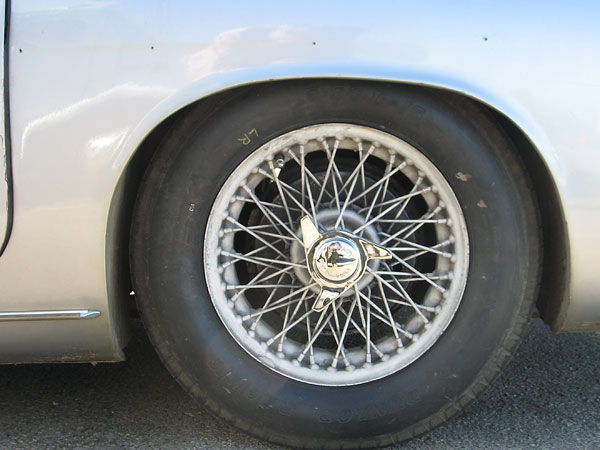
�
Wider wheels and tires would easily fit, but they're forbidden under the
�
Vintage Sports Car Club of America (VSCCA) rules that apply to the Peerless GT.
�
�
Except for the very first two photos above, all photos shown here are from November 2009 when we �
viewed the car at VRG's Turkey Bowl at Summit Point Motorsports Park, West Virginia. �
Photos by Curtis Jacobson for BritishRaceCar.com, copyright 2009. All rights reserved. �
The photo of Mark racing in the Jefferson 500 was provided by Mark, and has been published �
by exclusive permission. The original Peerless Cars Ltd. illustration is a period �
promotional photo, used under "fair use" guidelines.
�
| If you liked this article, you'll probably also enjoy these: | �|||||
 | �
Tivvy Shenton '55 Jaguar XK140 FHC | �
 | �
Joe Dockman '60 Daimler SP250 | �
 | �
George Wright '61 Triumph TR4 | �
| You're invited to discuss anything you've seen here on The British Racecar Motorsports Forum! | �|||||
�
Notice: all the articles and almost all the photos on BritishRacecar.com are by Curtis Jacobson.
�
(Photos that aren't by Curtis are explicitly credited.) Reproduction without prior written permission is prohibited.
�
Contact us to purchase images or reproduction permission. Higher resolution images are optionally available.
�

 �
�